Patrick Dangerfield didn’t have a great draft year but has blossomed into the AFL’s best
AS difficult as it may be to believe, there was a time Patrick Dangerfield didn’t snatch the ball out of a contest before setting off, leaving opponents clutching at air.
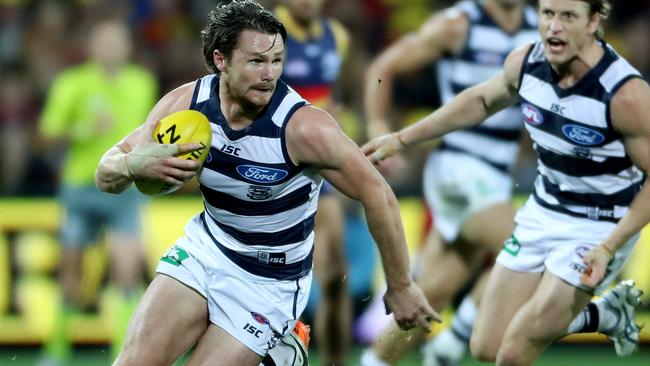
Geelong
Don't miss out on the headlines from Geelong. Followed categories will be added to My News.
AS difficult as it may be to believe, there was a time Patrick Dangerfield didn’t regularly snatch the ball out of a congested area before setting off on an explosive breakaway, leaving opponents clutching at air.
It has become one of football’s great sights, the midfield equivalent of a freakish Eddie Betts goal or forward line pressure act from Cyril Rioli.
But almost a decade ago, when 17-year-old Dangerfield was plying his trade for the Geelong Falcons, the trademark runs were spasmodic.
MEDAL FAVOURITE: DANGER TIPPED TO SMASH BROWNLOW RECORD
PATRICK DANGERFIELD: NOTHING WILL TAKE AWAY PRELIM PAIN
SURF COAST: ‘KRACKER’ ALWAYS CALLING DANGER HOME
It goes some way to explaining how nine clubs passed on the Moggs Creek junior at the 2007 national draft. There were other “bargains” in the same lucky dip — Cyril Rioli at pick 12, Harry Taylor at 17 and Alex Rance a pick later.
Scott Clayton, recruiting manager for the Bulldogs at the time, summed it up this way. “As a 17-year-old, Patrick Dangerfield definitely showed some explosive pace, but there were some long periods of not much,” Clayton said.
“His Vic Country stuff wasn’t drop-dead outstanding. He really wasn’t an obvious top-10 pick and could have gone at 20.”
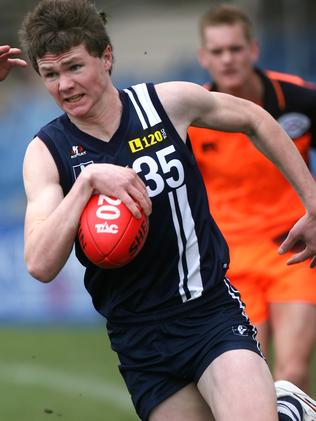
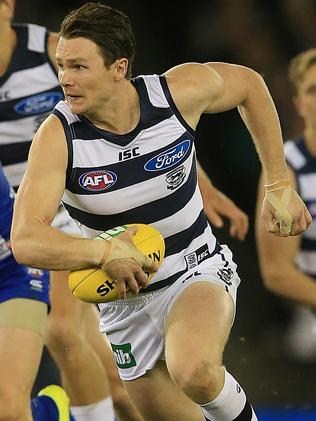
That’s where then Adelaide recruiting manager Matt Rendell comes into the picture. The former Fitzroy ruckman was in his first year as Adelaide recruiting boss and naturally enough was feeling the pressure.
He and his recruiting team, which included current Crows list boss Hamish Ogilvie, were excited by the young guns on offer in that 2007 draft.
There was an excitement machine from Scotch College, the aforementioned Rioli, the player Rendell thought would become the best in that draft, but someone who may or may not be happy to stay living away from his home in the Northern Territory.
Playing alongside Dangerfield at Geelong Falcons was a versatile key position player named Lachie Henderson; the youngest Selwood in Scott, or “Scooter”, was showing typical family traits up Bendigo way and from Swan Districts in Perth, Alex Rance was raw but promising.
Then there was a hard-nut midfielder from the Western Jets named Callan Ward, and if Rendell wanted the local factor, he need look no further than Port Adelaide lad Brad Ebert.
But there was something about the kid from Moggs Creek with a name that implied exciting things could happen on field, so he and Ogilvie put some more time into Dangerfield.
Rendell had seen him playing with the AIS in Perth prior to a trip to South Africa in 2007. It was a game where the boys played the men, a Perth side with Troy Cook leading the way in putting it to the upstarts.
Dangerfield didn’t do anything special in terms of getting the ball but nor at any stage did he, nor a teammate named Daniel Rich, take a backward step.
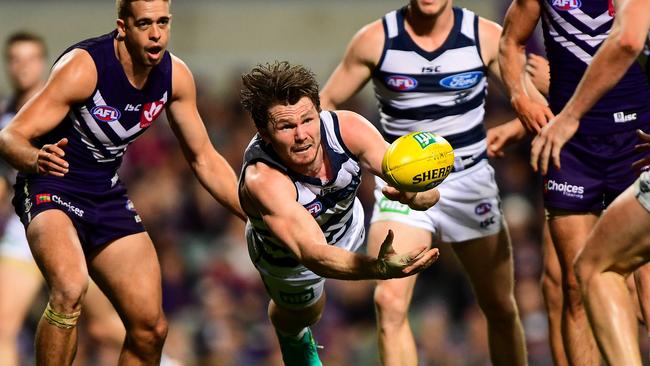
So Rendell knew the kid was tough, even if he didn’t seem to win a lot of possession.
And how to get him to win more possession was the issue because Rendell couldn’t use a pick 10 in his first draft on a player who excited the fans a few times a game while collecting 15 possessions.
“So I followed him during the year and to be fair, he wasn’t super,” Rendell said.
“He was averaging something like 14 possies playing as a half-back and back pocket where he was very conscious of his man. But you could see the competitive side.
“Near the end of the year I said to Hamish (Ogilvie) we have to see this bloke play in the midfield. They (Geelong Falcons) were seventh or eighth before the finals. I got Hamish to ring the club and ask could he play in the midfield, which the Falcons agreed to.
“Then I asked Hamish to go to the game and to ring me with an assessment of how the midfield move was working. Well he rang all right, and said he was outstanding.
“He might have only played a quarter or so and had about 12 possessions but Hamish said it was the best 12 you will ever see.
“The next week he had about 26 in the midfield in their last home-and-away game for the year.
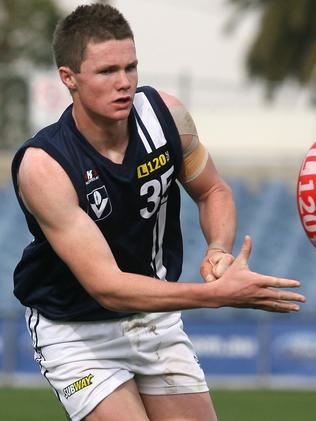
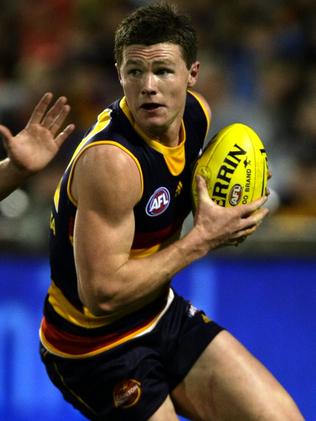
“They were brilliant possessions and very few recruiters were there to see him live. They would have seen the video but in this industry you have to see them live. You get very nervous about picking someone if you haven’t seen them in person.
“The problem was, by winning the last game the Falcons got to play in the first final the next week at Visy — so I thought we were stuffed because everyone would see him.
“But from memory they played him halfback where he played well, but it wasn’t the same as when he was in the midfield.
“Importantly they lost the game so there was no more exposure. I remember saying, ‘That’s gold Hamish, pure gold’.”
Then it became a matter of Dangerfield getting through to 10 to provide Adelaide with a midfielder who could hopefully freshen an ageing midfield with Mark Ricciuto announcing his retirement and Simon Goodwin and Tyson Edwards nearing the end.
A bonus for the Crows was the fact that Dangerfield — a 17-year-old in the last year that age was eligible to be drafted — had made it clear he would complete Year 12 at Oberon High in Geelong.
That put clubs off but Rendell was lucky to have a coach in Neil Craig who was happy to wait.
“Paddy went to the draft camp where he was a brilliant interview, speaking like he does today, and telling everyone he was going to stay at school, which I thought was the right thing for him to do,” Rendell said.
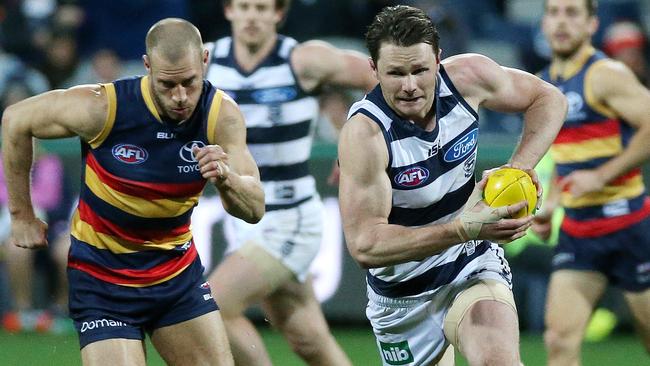
“VFL Victoria, to their credit, allowed him to play the next year in the TAC Cup. I think there had been a precedent a year or two earlier with the Sydney Swans.
“He basically took the p-ss out of the TAC Cup competition because he was so far ahead of his rivals.
“I heard there might have been a phone call to the Falcons saying you have to get this bloke out of the midfield because he’s already been picked, so he’s taking up a midfield spot.
“He kicked eight one game. I was just happy he could play in a great competition with a really good club in the Geelong Falcons.”
Dangerfield also played two games for the Crows late that year — in Rounds 20-21.
In 2009, his first full season, he played 21 matches, leading the club in hardball gets, signifying the arrival of the Danger man.
Rendell said he always knew the call of the Surf Coast would eventually prevail, but the risk was worth the outlay.
“Did I know he would return home? Yes, I knew he would go back at some stage, so seven years with Adelaide was a good result,” he said.
During the draft camp interview Rendell wanted to test Dangerfield’s confidence, so he asked him if he thought he was capable of going head-to-head with Trent Cotchin, who was widely acknowledged as the best midfielder of that year.
“Paddy looked at me and said ‘Of course I can’. There was nothing arrogant about it, just total self-belief.
“Then I asked, ‘Could Cotchin play on you in the midfield?’. He replied ‘No’ with real certainty.
“If you see his comments after he was drafted they were something like, ‘Once I get the ball I can run and carry it and once I get going, I’m hard to stop’. He certainly got that right.”
Originally published as Patrick Dangerfield didn’t have a great draft year but has blossomed into the AFL’s best

 I followed him during the year and to be fair, he wasn’t super ... but you could see the competitive side.
I followed him during the year and to be fair, he wasn’t super ... but you could see the competitive side. 

